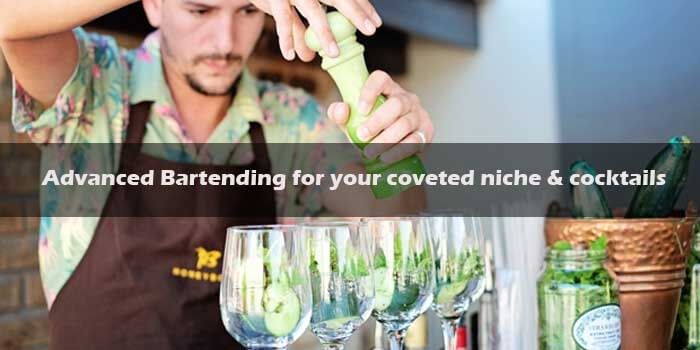Change is inevitable – so goes a saying. Whether you an entrepreneur or an employee of some organization you need to curve a niche for yourself to sustain and survive in the ever changing world. Extinction of Dinosaurs from earth urges the need for adaptability with the changing environment surrounding us. So, better be prepared ahead of time and competition keeping your fingers crossed.
Advanced Bartending as the name suggests deals in techniques and tricks which will further prune and hone your bartending skills. These tit-bits of knowledge will usher you in crafting a unique range of combinations in cocktails and a niche for yourself putting you a step ahead of the competition.
Top 11 things that you should know under advanced bartending:
-
Measuring Parts
Cocktail recipes generally talk about measurements in ounces, dashes and splashes and as a bartender you are well acquainted with such terminologies; but some of the recipes talk about “parts”. A part means any equal part and can be taken as a unit of your jigger. Get your glassware which matches your drink.
-
Pouring Order
Pouring order of the ingredients into the cocktail shaker conforms to the nature of the drink and the style of the bartender. Even though there’s no fixed rule book on this it is still relevant to follow an order of pouring which could be consequential to the situations. For example: DeGroff’s rule of thumb in making a sour drink is – first pour the sour, then add sweet which must be followed by dash, strong and ice. The common practice of today however entails that you begin with the spirit and then add liqueurs, mixers and enhancers on top of it. The merit of this order is that you can gauge the subsequent ratios based on the base ingredient; i.e., liquor.
-
Measuring Shots in a Bottle
This is important for you to know since it will help you decide on the crucial aspect of stock requirement vis-à-vis your guests flow at the bar. There’s no quick and straight jacket formula on this as it’s a matter of experience that would come to you naturally.
Read : How To Plan The Best End Of Season Barbeque?
-
Shelf Life of Liquor
Not every liquor has a fixed shelf life. You need to know which one has and which one don’t. For example: a bottle of scotch will remain the same in taste as of the day of its manufacture even after 20 years; but beers and some of the other liquors will turn into waste after its’ shelf life especially after breaking open its seal. But, you can effectively enhance its shelf life provided you tighten the bottle with its original cork; avoid exposing it to the extreme cold or heat and direct sun light.
-
Freezing of Liquor
Liquors too have a freezing point which is far below the freezing point of water. The freezing point of liquors hovers between zero degree Celsius and minus 114 degree Celsius.
-
Importance of Ice
Ice forms an integral part of cocktails and mixed drinks. Ice can only be taken as an exception in hot drinks and Champagne cocktail. There are four basic forms of ice that are used in cocktails or drinks based on its’ nature; namely cubes, cracked, shaved and block. While cubes can be used in almost every drink, cracked ones are used in frozen drinks, shaved ice is used in soda machines and block ice is primarily used in chilling party punches.
-
Specific Gravity Chart
The specific gravity of each ingredient holds key to its usage in the layered drink. The ingredient with the highest gravity must be used at the bottom and alike.
-
Creating Drink Menu
A drink menu helps you tailor the drinks as per the occasion. Besides, guests can pick their choice. A menu also reduces the stocking cost significantly as you don’t need to stock a full bar.
-
Eco-friendly Bartending
As a bartender you can’t shy away from your responsibility to the environment. You can become eco-friendly by following the simple steps like use green spirits, recycle empty bottles, ditch the disposable and plastic barware, buy used or new quality tools and glassware, buy fresh local mixers and garnishes, control ice use, conserve energy, conserve water, change lighting and use green cleaners in lieu of chemical cleansers.
-
Fruit Flavor in Cocktail
This comes from extensive experience of working as a bartender. For example: almond pairs well with apple, apricot, banana, caramel, cherry, coffee, fig, honey, orange, peach, pear and plum. Such pairing holds potential to the success of your cocktail.
-
Herbs and Spices in Mixology
The craft of cocktail hinges on a bartender’s capacity to think afresh. Pairing of herbs and spices too comes from the vast experience of a bartender and the challenge of a successful bartender lies in crafting the right combination to achieve balanced drinks. Have a happy bartending!
